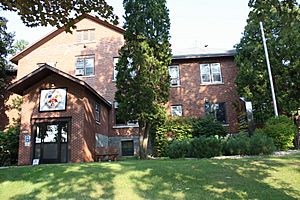Menominee Indian Reservation facts for kids
Quick facts for kids
Menominee Indian Reservation
Omāēqnomenēw-Otāēskonenan
|
||
|---|---|---|

Menominee Tribal Hall
|
||
|
||

Location in Wisconsin
|
||
| Tribe | Menominee Indian Tribe of Wisconsin | |
| Country | United States | |
| State | Wisconsin | |
| County | Menominee | |
| Headquarters | Keshena | |
| Government | ||
| • Body | Menominee Legislature | |
| Area | ||
| • Total | 362.791 sq mi (939.62 km2) | |
| • Land | 355.444 sq mi (920.60 km2) | |
| • Water | 7.347 sq mi (19.03 km2) | |
| Area includes off-reservation trust land | ||
| Population
(2020)
|
||
| • Total | 3,293 | |
| • Density | 9.3/sq mi (3.6/km2) | |
| • Reservation | 3,032 | |
| • Off-reservation trust land | 261 | |
| Website | menominee-nsn.gov | |
The Menominee Indian Reservation is a special area of land in northeastern Wisconsin. It is managed by the United States government for the Menominee Tribe of Wisconsin. This reservation is the largest Indian reservation located east of the Mississippi River.
In the Menominee language, the reservation has two names. One is Omāēqnomenēw-Otāēskonenan, which means "Menominee Thing Set Apart". The other name is omǣqnomenēw-ahkīheh, meaning "in the Menominee Country".
Contents
Exploring the Menominee Land
The Menominee Indian Reservation covers about 360 square miles (932 square kilometers). Most of this land is in Menominee County, Wisconsin. There is also a small piece of land next to it in Shawano County, Wisconsin. These two areas are usually managed as one unit.
The reservation is mostly the same as Menominee County, Wisconsin. However, some small parts of the county are not part of the reservation. The Menominee Tribe manages about 98.86% of the county's land. The largest non-reservation area is in Keshena, Wisconsin.
Key Communities on the Reservation
The Menominee Reservation has several important communities. These are places where people live and gather. The most populated communities are Legend Lake and Keshena.
| Community | Menominee Name | 2020 Population |
|---|---|---|
| Keshena | Kesīqnæh | 1,257 |
| Legend Lake | 1,670 | |
| Middle Village | Nanāweyah omenīkān | 290 |
| Neopit | Neyōpet | 616 |
| Zoar | Saqnawæpaniw | 107 |
Learning and Language
The Menominee Tribe values education. They started their own school, the College of the Menominee Nation, in 1993. This college is a special type of school called a tribal college. It helps tribal members get a higher education. The main campus is in Keshena.
Speaking the Menominee Language
On the reservation, people speak both English and the Menominee language. The Menominee language is part of the Algonquian language family. It is an important part of the tribe's culture and history.
Understanding Tribal Laws
The Menominee Reservation is unique in Wisconsin. It is the only reservation that is not fully under state law because of something called Public Law 280. This means that the Menominee Nation or the federal government usually handles legal matters for tribal members on the reservation.
However, the state of Wisconsin can still get involved in crimes on the reservation. This happens if neither the person who committed the crime nor the victim is a tribal member.
People of the Menominee Reservation
In 2020, about 3,293 people lived on the Menominee Reservation and its nearby trust land. Most of the people living here are Native American. A smaller number of residents are White or from other backgrounds.
How the Menominee Tribe Thrives
The Menominee Tribe has a strong economy. They manage their resources carefully.
Forestry and Lumber Production
A big part of the Menominee Indian Reservation is covered by a large forest. The Menominee Tribe has been taking care of this forest for over 150 years. They harvest about 15 million board feet of wood each year. This is done in a way that protects the forest for future generations.
The tribe's work in forestry has been praised by the United Nations. Wood from their forest has even been used in big projects, like the Milwaukee Bucks arena, Fiserv Forum. Many types of trees grow here, including white ash, maple, oak, and pine.


